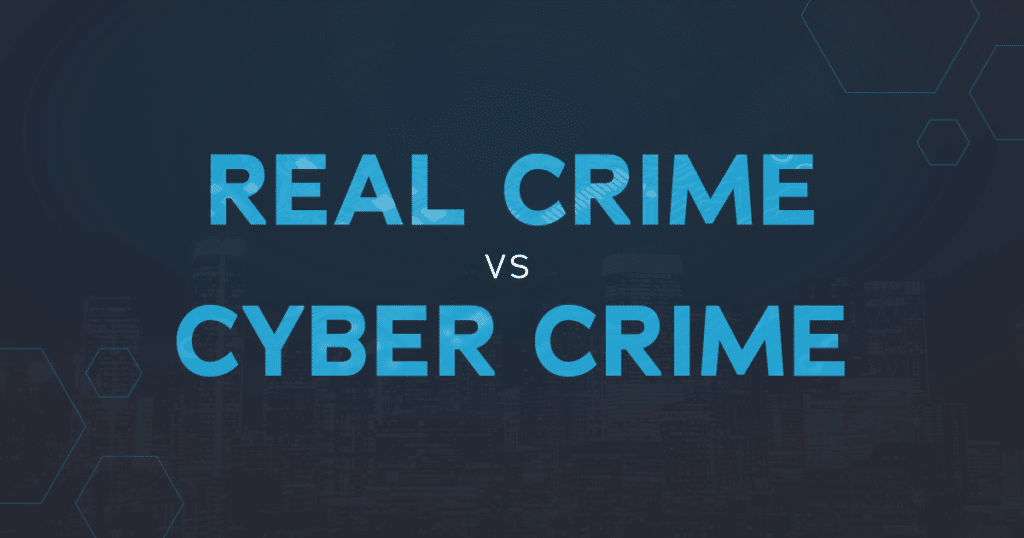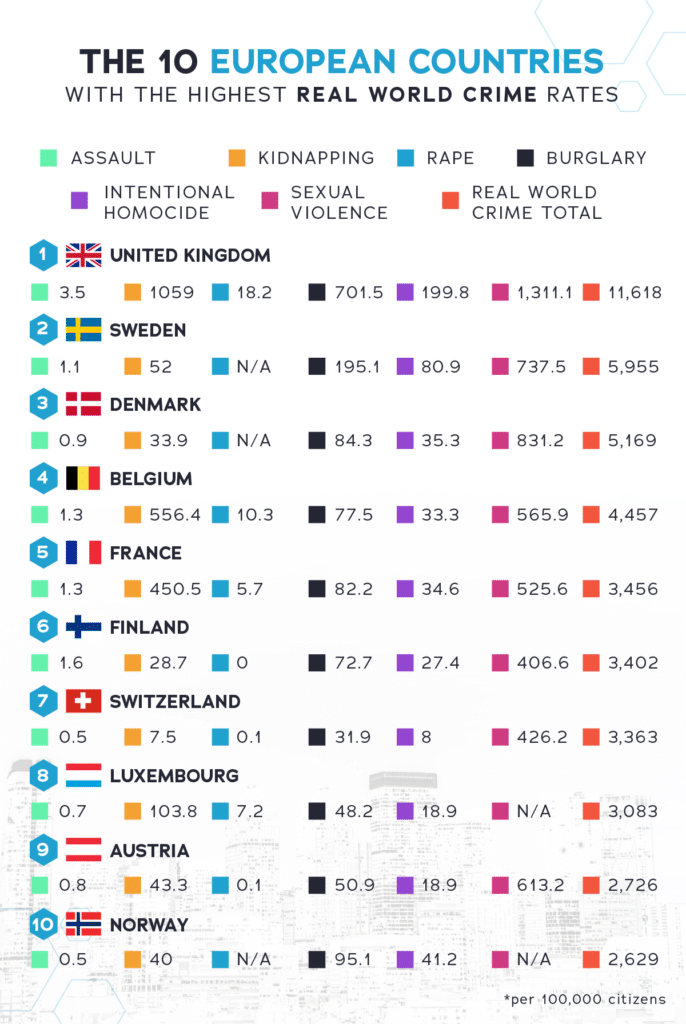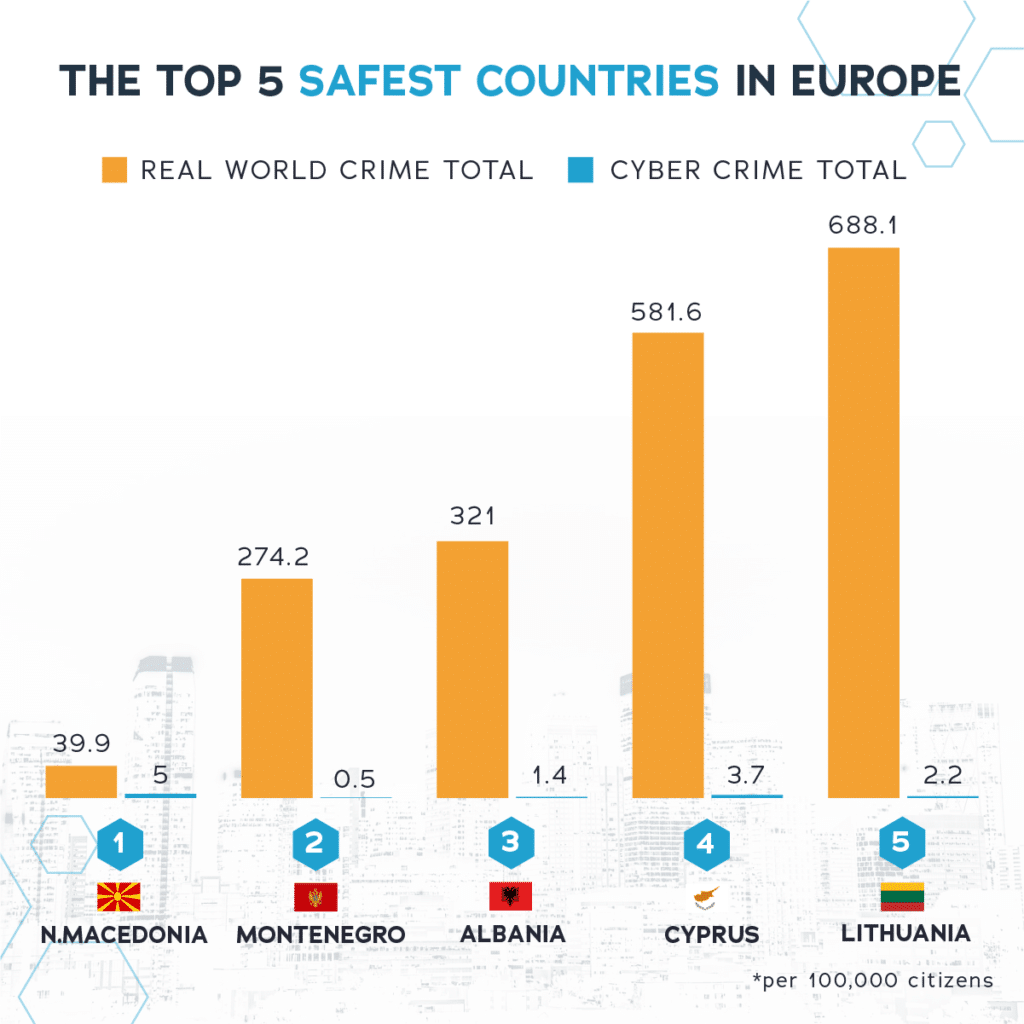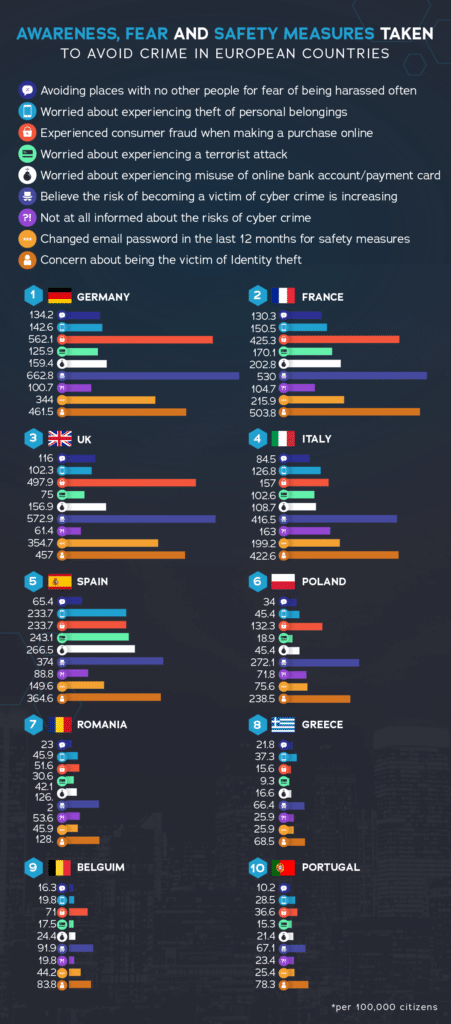What is the reality of real-world and cyber crime in Europe?

Are you aware of just how often real-world offences and cyber crimes are committed across Europe and which countries are most affected?
TechRobot has carried out research on real-world crime and cyber crime rates of the 36 OECD countries, as well as sharing how well informed citizens are about crime. They have also revealed whether Europeans feel concerned about experiencing certain crimes and how regularly each European country changed their email password in the last 12 months, in response to cyber crime.
Europe is considered one of the safest continents in the world and is the only continent to have not seen a decline in safety since 2009, according to the Institute for Economics and Peace. In addition, technical innovation has been a fundamental source for good, allowing convenience, access to information and increased communication. However, this also means that there is a new type of crime citizens need to be aware of – cyber crime.
The Internet Organised Crime Threat Assessment (IOCTA) has stated that cyber crime is becoming more aggressive and confrontational. Phishing, pharming and fraudulent credit/debit card misuse are just some of the types of cyber crimes users need to be aware of.
Which are Europe’s most dangerous countries for real-world crime?

We analysed the real-world crime rates across Europe using metrics such as the number of assaults, kidnapping, rapes, intentional homicides, sexual violence, burglary and then real-world crime total. The analysis reveals that the UK is the most dangerous country in Europe. With high rates of kidnapping, assault, burglary and sexual violence, the UK suffers 11,618 cases per 100,000 citizens.
The Scandinavian nation, Sweden is the next most dangerous country in Europe with high levels of sexual violence and burglary. For every 100,000 people in Sweden, 195.11 experience sexual violence. Although the rates of this crime are high in Sweden, only 18.29 citizens per 100,000 avoid places where there are no other people around for fear of being assaulted or harassed.
The total levels of real-world crime in Sweden are the second highest in Europe at 5,955 per 100,000 inhabitants. Also, Swedish citizens are surprisingly not concerned about experiencing theft of mobile phones, wallets or purses. Only 12.19 per 100,000 citizens are very fearful of this happening, even though Sweden ranks the third-highest for burglary at a rate of 737.52 per 100,000 citizens.
Denmark, another Scandinavian country, ranks as the third most dangerous country in Europe. Their levels of total real-world crime sit at 5,168.85 per 100,000 citizens. The country encounters sexual violence at a rate of 84.31 per 100,000 people, with only 5.23 in every 100,000 avoiding being alone in a place for fear of being harassed.
Although Denmark has a high crime rate overall in Europe, the rates of intentional homicide occur at a rate of 0.93, which is only the 18th highest in Europe. Despite this, Denmark has the second-highest burglary rate out of the 36 countries (831.15 per every 100,000 people).
Which are Europe’s most dangerous countries for cyber crime?

The analysis reveals that the most dangerous country for cyber crime is also the United Kingdom. According to a study carried out by Detica for the Cabinet Office, the UK suffers losses of £27 billion per annum due to Cyber Crime, with the predominant victims being UK businesses. 13.64 for every 100,000 citizens in the UK experience financial losses due to cyber crime, which is the highest rate in Europe.
In addition, with the UK having the highest rate of online ID theft (20.5 in every 100,000 people) and credit/debit card fraud (47.7 for every 100,000 citizens), it’s not surprising that people living in the UK have changed their email password the most out of all the countries researched in the last 12 months. These were changed at a rate of 354.68 per every 100,000 people.
Just behind the UK is France, which has the second-highest rate of cyber crime in Europe at 497.2 per 100,000 citizens. French people experience social media account hacking at a rate of 19.63 in every 100,000 people, which is also the second-highest amongst the countries researched.
Lots of people tend to use very simple, easy-to-guess passwords and reuse these for many different accounts. This allows hackers to easily get into more than one account. This may also suggest why French people believe the risk of becoming a victim of cyber crime is increasing; the rate of this concern is at 529.95 per 100,000.
The country with the largest population, Germany, comes third for being most at risk from cyber crime. German people experience the misuse of personal information online more than any other country in Europe, in particular phishing. This crime is a type of online scam where cyber criminals impersonate legitimate organizations in order to steal sensitive information. This impersonation can come in the form of an email, text message, advertisement or other means.
With the highest rate of this crime at 302 per 100,000 citizens, it is not surprising that 662.81 per 100,00 German people believe that the risk of becoming a victim of cyber crime is increasing. Despite this, many Germans are not at all informed about the risks of cyber crime, with 100.68 for every 100,000 citizens lacking knowledge about the dangers. Germany also has the fifth-highest rate of experiencing pharming, as this scam happens to 58.73 Germans for every 100,000. This is another online scam similar to phishing in which a website’s traffic is manipulated by a hacker, and confidential information can be stolen. Essentially, it is a cyber criminal creating a fake website and then redirecting users to it.
What are Europe’s safest countries relating to all crime offences?

North Macedonia ranks as the safest country in the study, with an extremely low rate of 39.89 real-world crime offences and a rate of 5 cyber crime offences per 100,000 citizens. Although the country isn’t the safest for every crime in Europe, for instance, the intentional homicide rates are 1.49 per 100,000 people which is the 8th worst in Europe, it consistently ranks low in all categories of real-world crime. Even though the country is only the thirteenth safest country relating to cyber crime, compared to the UK’s rate of 572.94 offences in every 100,000 people which makes it the most dangerous, it is relatively safe.
From phishing and social media account hacking to fraudulent credit/debit card use and online identity theft, the Balkan country, Montenegro has extremely low rates of cyber crime. The total amount of cyber crime per 100,000 citizens is 0.5, making it the safest country. The country experiences the lowest rates of phishing throughout Europe at a rate of 0.19 per 100,000 citizens as well as the overall misuse of personal information on the internet which is 0. Moreover, the total real-world crime rates are 274.20 per 100,000 inhabitants, making Montenegro the second safest country in Europe when it comes to these types of crime.
Analysis shows that 320.98 Albanians will experience real-world crime in every 100,000, making it the third safest country in Europe. They have the lowest rate of burglary at 5.23, compared to that of the UK which has the highest rate of 1,311.13 per 100,000 British people. Albania is also the safest country for fraudulent credit/debit card use and experiencing a financial loss due to Cyber Crime, as 0 people per every 100,000 are affected by these crimes.
Does real-world crime or cyber crime affect Europeans more?
The rates of real-world crime are higher than cyber crime for every country researched, making it more of a threat for inhabitants in these countries.
Burglary, a crime that significantly affects all the countries, is experienced at a rate of over 50 per every 100,000 citizens for every country except Albania, which only has a rate of 5.23. This could explain why European countries fear having their mobile phone, wallet or purse stolen. In Spain the rate of concern for this crime is at 233.73 in every 100,000 Spanish citizens.
Furthermore, with the threat of cyber crime increasing, so is the fear of experiencing an attacker impersonating you online. From January to June 2020, £58 million was lost to impersonation scams in the UK alone, according to UK Finance. Cyber criminals can pretend to be the police, banks, or government organisations in order to get their victims to reveal sensitive information.
The UK, France and Germany all have the highest rates of impersonation online, at 456.99, 503.78 and 461.45 per 100,000 people respectively. Although real-world crime does affect Europeans at a higher rate than cyber crime, most European citizens feel that the risks of cyber crime are increasing. Particularly in Germany, UK and France which have the highest rates of concern at 662.81, 572.94 and 529.95 per 100,000 citizens respectively.
Which countries are the most concerned by the threat of real-world and cyber crime

Italy is the fourth most dangerous country for cyber crime in the OECD. Cyber crime offences impact Italians at a rate of 229.40 per every 100,000 citizens. Surprisingly, Italy has the highest rates of citizens not being aware of the risks of cyber crime at all; 162.99 citizens per every 100,000 are not conscious of the serious ramifications. However, Italians seem to be more aware of the increasing risk, as the rate of Italians believing the risk of becoming a victim of cyber crime is 416.54 per 100,000 citizens.
Changing your email password every couple of months is a great way to keep your personal information and data safe and cyber secure. Analysis reveals which countries in Europe changed their email password in the last 12 months, in response to taking measures against cyber crime. They found that the UK, Germany and France had the highest amount of email password changes in the last 12 months with rates as high as 354.68, 344 and 215.91 per 100,000 citizens. Whereas the countries that had the lowest number of password changes in the last year were Malta, Luxembourg and Finland with low rates of 1.64, 2.92 and 3.05 respectively.
Overall Europeans seem to be worried about cyber crime and feel the risks of these types of crimes are increasing
Real-world crime is prevalent, with the majority of the countries in Europe experiencing over 1,000 cases of crime per 100,000 citizens. Furthermore, the rates of cyber crime are relatively low apart from five main countries, the UK, France, Germany, Italy and Spain. These five countries have greater rates of cyber crime, in particular fraudulent credit/debit cards, social media hacking and online impersonation. Europeans seem to be worried about cyber crime and feel the risks of these types of crimes are increasing, particularly in the UK, France, Italy, Spain and Germany.
Methodology and Sources
TechRobot analysed data about the rates of real-world crime and cyber crime of 36 countries in Europe, as well as analysing how well informed citizens are about cyber crime, how fearful and what measures citizens take in order to protect themselves against real-world and cyber crime. See the full study here.
- https://worldpopulationreview.com
- https://tradingeconomics.com
- https://ec.europa.eu
- https://fra.europa.eu